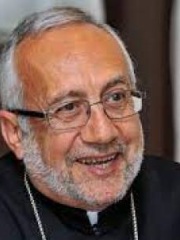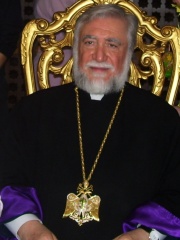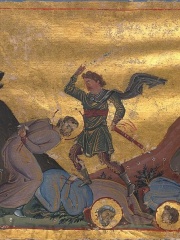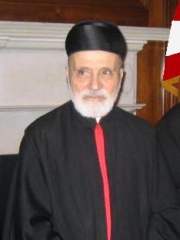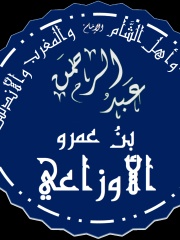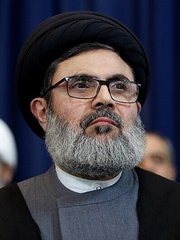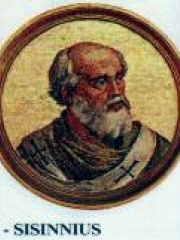
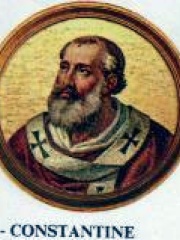
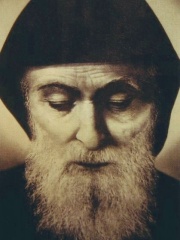
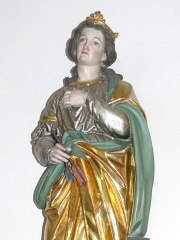
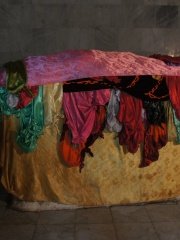
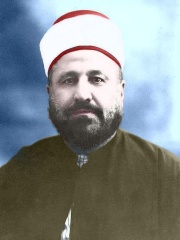
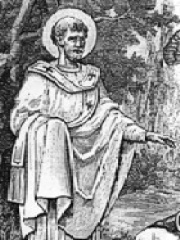
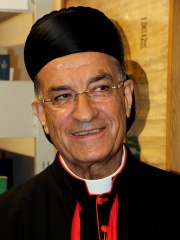
The Most Famous
RELIGIOUS FIGURES from Lebanon
This page contains a list of the greatest Lebanese Religious Figures. The pantheon dataset contains 3,187 Religious Figures, 19 of which were born in Lebanon. This makes Lebanon the birth place of the 27th most number of Religious Figures behind Portugal, and Ireland.
Top 10
The following people are considered by Pantheon to be the top 10 most legendary Lebanese Religious Figures of all time. This list of famous Lebanese Religious Figures is sorted by HPI (Historical Popularity Index), a metric that aggregates information on a biography's online popularity. Visit the rankings page to view the entire list of Lebanese Religious Figures.

1. Pope Sisinnius (650 - 708)
With an HPI of 76.59, Pope Sisinnius is the most famous Lebanese Religious Figure. His biography has been translated into 70 different languages on wikipedia.
Pope Sisinnius (died 4 February 708) was the bishop of Rome from 15 January 708 to his death on 4 February 708. Besides being Syrian and his father being named John, little is known of Sisinnius' early life or career. At the time of his election to the papal throne, Sisinnius suffered from severe gout, leaving him weak. During the course of his twenty-day papacy, Sisinnius consecrated a bishop for Corsica and ordered the reinforcement of the walls surrounding the papal capital of Rome. On his death, Sisinnius was buried in Old St. Peter's Basilica. He was succeeded by Pope Constantine.

2. Pope Constantine (664 - 715)
With an HPI of 76.23, Pope Constantine is the 2nd most famous Lebanese Religious Figure. His biography has been translated into 69 different languages.
Pope Constantine (Latin: Constantinus; 664 – 9 April 715) was the bishop of Rome from 25 March 708 to his death on 9 April 715. One of the last popes of the Byzantine Papacy, the defining moment of his pontificate was his 710/711 visit to Constantinople, where he compromised with Justinian II on the Trullan canons of the Quinisext Council. The city's next papal visit occurred in 1967.

3. Charbel Makhlouf (1828 - 1898)
With an HPI of 73.82, Charbel Makhlouf is the 3rd most famous Lebanese Religious Figure. His biography has been translated into 34 different languages.
Charbel Makhlouf, O.L.M. (born Youssef Antoun Makhlouf; Arabic: شربل مخلوف, May 8, 1828 – December 24, 1898) was a Lebanese Maronite monk and priest. During his life, he obtained a wide reputation for holiness, and for his ability to unite Christians, Muslims and Druze. He was a member of the Baladites. He is known among Lebanese Christians as the "Miracle Monk of Lebanon" because of the favours received through his intercession, especially after prayers are said at his tomb in the Monastery of Saint Maron in Annaya, Lebanon. He was beatified in 1965 and canonized in 1977 by Pope Paul VI. His feast is celebrated on 24 July by the Latin Church, and on the third Sunday of July by the Maronite Church. The Medal of Saint Charbel was created in his honor.

4. Christina of Bolsena (210 - 304)
With an HPI of 72.38, Christina of Bolsena is the 4th most famous Lebanese Religious Figure. Her biography has been translated into 27 different languages.
Christina of Tyre, also known as Christine of Bolsena, or in the Eastern Orthodox Church as Christina the Great martyr, is venerated as a virgin martyr of the third century. Archaeological excavations of an underground cemetery constructed over her tomb have shown that she was venerated at Tyre by the fourth century.

5. Eusebius of Nicomedia (280 - 341)
With an HPI of 69.87, Eusebius of Nicomedia is the 5th most famous Lebanese Religious Figure. His biography has been translated into 38 different languages.
Eusebius of Nicomedia (; Ancient Greek: Εὐσέβιος; died 341) was an Arian priest who baptised Constantine the Great on his deathbed in 337. A fifth-century legend evolved that Pope Sylvester I was the one to baptise Constantine, but this is dismissed by scholars as a forgery "to amend the historical memory of the Arian baptism that the emperor received at the end of his life, and instead to attribute an unequivocally orthodox baptism to him". He was a bishop of Berytus (modern-day Beirut) in Phoenicia. He was later made the bishop of Nicomedia, where the Imperial court resided. He lived finally in Constantinople from 338 up to his death.

6. Sheikh Adi ibn Musafir (1073 - 1162)
With an HPI of 67.80, Sheikh Adi ibn Musafir is the 6th most famous Lebanese Religious Figure. His biography has been translated into 20 different languages.
Adi ibn Musafir (Kurdish: شیخادی, romanized: Şîxadî, Arabic: عَدِيُّ بْنُ مُسَافِرْ; born 1072–1078, died 1162) was a Sunni Muslim sheikh who founded the Adawiyya order. He is also considered a Yazidi saint. The Yazidis consider him as an avatar of Tawûsî Melek, which means "Peacock Angel". His tomb at Lalish, Iraq is a focal point of Yazidi pilgrimage. He was an Arab from the Umayyad dynasty. He had distant Kurdish heritage as a direct descendant of Marwan II, who was born to a Kurdish mother.

7. Rashid Rida (1865 - 1935)
With an HPI of 67.41, Rashid Rida is the 7th most famous Lebanese Religious Figure. His biography has been translated into 31 different languages.
Sayyid Muhammad Rashīd Rida Al-Hussaini (Arabic: سيد محمد رشيد رضا الحسيني, romanized: Muḥammad Rashīd Riḍā; 1865 – 22 August 1935) was an Islamic scholar, reformer, theologian and revivalist. An early Salafist, Rida called for the revival of hadith studies and, as a theoretician of an Islamic state, condemned the rising currents of secularism and nationalism across the Islamic world following the abolition of the Ottoman sultanate. He championed a global pan-Islamist program aimed at re-establishing a Caliphate to unite diverse peoples under a single global Islamic authority. As a young hadith student who studied al-Ghazali and Ibn Taymiyya, Rida believed reform was necessary to save the Muslim communities, eliminate Sufist practices he considered heretical, and initiate an Islamic renewal. He left Syria to work with Abduh in Cairo, where he was influenced by Abduh's Islamic Modernist movement and began publishing al-Manar in 1898. Through al-Manar's popularity across the Islamic world, Rida became one of the most influential Sunni jurists of his generation, leading the Arab Salafi movement and championing its cause. He was Abduh's de facto successor and was responsible for a split in Abduh's disciples into one group rooted in Islamic modernism and the other in the revival of Islam. Salafism, also known as Salafiyya, which sought the "Islamization of modernity," emerged from the latter. During the 1900s Rida abandoned his initial rationalist leanings and began espousing Salafi-oriented methodologies such as that of the Ahl-i Hadith movement. He later supported the Wahhabi movement, revived works by Ibn Taymiyyah, and shifted the Salafism movement into a more conservative and strict Scripturalist approach. He is regarded by a number of historians as "pivotal in leading Salafism's retreat" from the rationalist school of Abduh. He strongly opposed liberalism, Western ideas, freemasonry, Zionism, and European imperialism, and supported armed Jihad to expel European influences from the Islamic World. He also laid the foundations for anti-Western, pan-Islamist struggle during the early 20th century.

8. Frumentius (400 - 383)
With an HPI of 66.97, Frumentius is the 8th most famous Lebanese Religious Figure. His biography has been translated into 32 different languages.
Saint Frumentius (Ge'ez: ፍሬምናጦስ; died c. 383) was a Phoenician Christian missionary and the first bishop of Axum who brought Christianity to the Kingdom of Aksum. He is sometimes known by other names, such as Abuna ("Our Father") and Aba Salama ("Father of Peace"). He was a native of Phoenicia, born in Tyre, modern day Lebanon. As a boy, he was captured with his brother on a voyage, and they became slaves to the King of Axum. He freed them shortly before his death, and they were invited to educate his young heir. They also began to teach Christianity in the region. Later, Frumentius traveled to Alexandria, Egypt, where he appealed to have a bishop appointed and missionary priests sent south to Axum. Thereafter, he was appointed bishop and established the Church in Ethiopia, converting many local people, as well as the king. His appointment began a tradition that the Patriarch of Alexandria appoint the bishops of Ethiopia.

9. Bechara Boutros al-Rahi (b. 1940)
With an HPI of 66.65, Bechara Boutros al-Rahi is the 9th most famous Lebanese Religious Figure. His biography has been translated into 29 different languages.
Bechara Boutros Al-Ra'i (or Raï; Arabic: بِشَارَة بُطرُس الرَّاعِيّ, romanized: Mor Bişâre Butrus er-Râî; Syriac: ܡܪܢ ܡܪܝ ܒܫܐܪܐ ܦܛܪܘܣ ܐܠܪܐܥܝ; Latin: Béchara Petrus Raï) (born 25 February 1940) is the 77th Maronite Patriarch of Antioch, and head of the Maronite Church, a position he has held since 15 March 2011, succeeding Patriarch Nasrallah Boutros Sfeir. Rahi was made a cardinal on 24 November 2012 by Pope Benedict XVI. He is a member of the Mariamite Maronite Order.
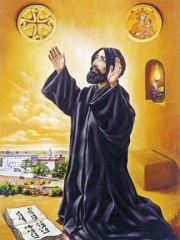
10. Nimatullah Kassab (1808 - 1858)
With an HPI of 66.26, Nimatullah Kassab is the 10th most famous Lebanese Religious Figure. His biography has been translated into 23 different languages.
Nimatullah Kassab , also known as "Al-Hardini" in reference to his birth village, (1808 – 14 December 1858) was a Lebanese monk, priest and scholar of the Maronite Church. He has been declared a saint by the Catholic Church.
People
Pantheon has 19 people classified as Lebanese religious figures born between 210 and 1964. Of these 19, 4 (21.05%) of them are still alive today. The most famous living Lebanese religious figures include Bechara Boutros al-Rahi, Raphaël Bedros XXI Minassian, and Aram I. The most famous deceased Lebanese religious figures include Pope Sisinnius, Pope Constantine, and Charbel Makhlouf. As of April 2024, 2 new Lebanese religious figures have been added to Pantheon including Hashem Safieddine, and Aïda Yazbeck.
Living Lebanese Religious Figures
Go to all RankingsBechara Boutros al-Rahi
1940 - Present
HPI: 66.65
Raphaël Bedros XXI Minassian
1946 - Present
HPI: 63.18
Aram I
1947 - Present
HPI: 60.27
Aïda Yazbeck
HPI: 34.76
Deceased Lebanese Religious Figures
Go to all RankingsPope Sisinnius
650 - 708
HPI: 76.59
Pope Constantine
664 - 715
HPI: 76.23
Charbel Makhlouf
1828 - 1898
HPI: 73.82
Christina of Bolsena
210 - 304
HPI: 72.38
Eusebius of Nicomedia
280 - 341
HPI: 69.87
Sheikh Adi ibn Musafir
1073 - 1162
HPI: 67.80
Rashid Rida
1865 - 1935
HPI: 67.41
Frumentius
400 - 383
HPI: 66.97
Nimatullah Kassab
1808 - 1858
HPI: 66.26
Pamphilus of Caesarea
240 - 309
HPI: 64.79
Nasrallah Boutros Sfeir
1920 - 2019
HPI: 62.29
Abd al-Rahman al-Awza'i
707 - 774
HPI: 62.04
Newly Added Lebanese Religious Figures (2025)
Go to all RankingsOverlapping Lives
Which Religious Figures were alive at the same time? This visualization shows the lifespans of the 6 most globally memorable Religious Figures since 1700.

